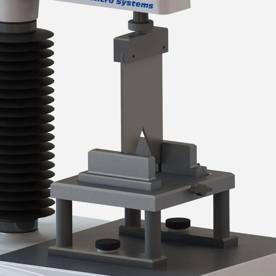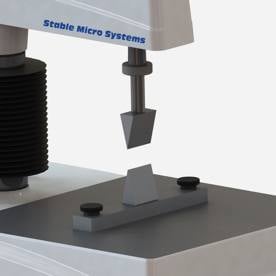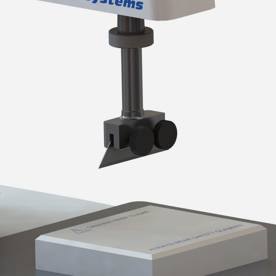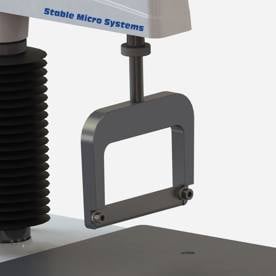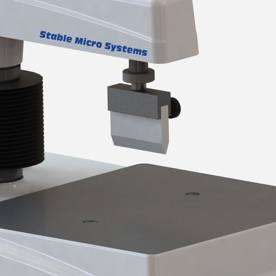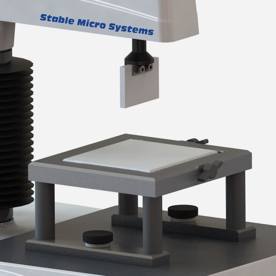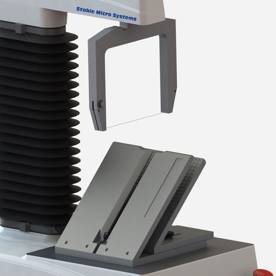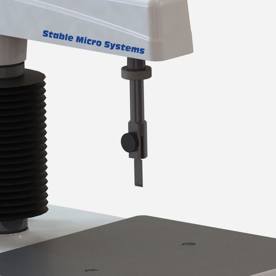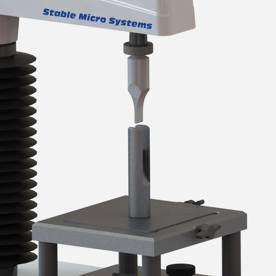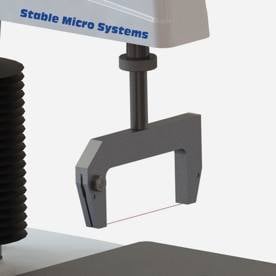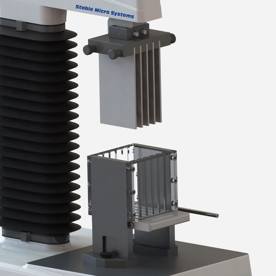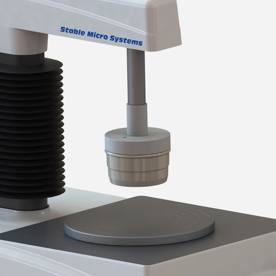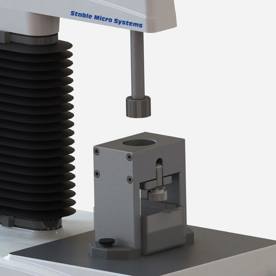Cutting and shearing testing
Learn about cutting and shearing testing, when to use these test types and the typical probes and attachments for use on a Texture Analyser.




What is a cutting/shearing test?
A cutting or shearing test uses a blade or multi-blade attachment on a Texture Analyser to measure how a sample resists slicing or shearing. The instrument records the maximum cutting force and work of shear (area under the force-distance/time curve), which together quantify product firmness, toughness, or bite resistance of texture for foods, gels, meats, and other viscoelastic or fibrous products.
Although often called “shear” tests, these methods involve a combination of shear, compression, and tension forces, making them empirical rather than fundamental measurements of true shear modulus.
How a Texture Analyser performs a cutting / shearing test
The Texture Analyser drives a blade through the sample at a controlled speed, continuously measuring force versus distance. The resulting curve identifies how easily the sample fractures or shears. High peak forces indicate toughness, while lower forces imply tenderness or weakness.
Types of cutting / shearing test
Cutting and shearing methods differ by blade design, geometry, and the type of deformation produced. They can be broadly grouped into:
|
Test type |
Primary motion / action |
Typical application |
|
Single blade cutting |
Blade slices through the sample |
Firmness or toughness of solid homogeneous foods |
|
Multi-blade shearing |
Multiple blades cut simultaneously |
Bulk or heterogeneous materials |
|
True shear |
Opposite stresses applied internally |
Tablet lamination or powder flow |
Typical graphs produced and properties measured
Cutting/shearing tests can quantify a wide range of textural properties, including:
- Cutting force/Bite force - peak resistance to the blade
- Shear force - resistance to lateral motion
- Toughness - resistance to fracture before rupture
- Firmness - overall strength against cutting load
Single or multiple parameters such as peak force, work of shear, adhesion upon blade withdrawal and slope/modulus can be collected from the graph. Understanding these parameters allows direct comparison between samples or production batches.
To learn more about how these properties are measured, visit our Textural Properties page.
Choosing a blade or attachment for sample measurement
Blade geometry, edge design, and slot configuration determine the type of data obtained. Selecting the correct attachment ensures meaningful and repeatable results.
Standard and Warner–Bratzler blades
|
Attachment |
Typical use |
Notes |
|
Blade Set |
General-purpose cutting tests across a wide range of samples; can be used for full cut-through tests when paired with a slotted guide. |
Most common cutting choice. Includes reversible knife/guillotine edge and a Warner-Bratzler blade. Blade is not very sharp, so fragile samples may be compressed before cutting begins. |
|
Light Knife Blade |
Cutting soft to medium-firm samples where a low-cost option is preferred. |
Economical blade; suited to less demanding cutting applications. |
|
Fracture Wedge Set |
Assessing cutting/fracture from both top and bottom of a sample using opposing wedges. |
Upper and lower wedges each have a 30° cutting angle and 30 mm width. Maximum sample width limited to 30 mm. |
|
Craft Knife Adapter + Extended Craft Knife |
Precise cutting of small or hard samples; extended version for deeper/wider cuts. |
Uses disposable blades to maintain sharpness. Extended craft knife increases cutting depth and width capability. |
Specialised blades for defined standards/purposes
|
Attachment |
Typical use |
Notes |
|
AACC Standard Pasta Blades |
Cooked pasta firmness/quality testing to AACC Method 66-50.01 or AACCI 66-52.01. |
Specifically dimensioned for these standards; rarely used for other methods or sample types. |
|
Asian Noodle Rig |
Measuring noodle bite strength (typically for Asian-style noodles). |
Developed at the Wheat Marketing Centre specifically for noodle bite-strength assessment. |
|
Miller-Hoseney Toughness Rig |
Measuring bread toughness by pulling a wire through a bread slice. |
Method draws a wire vertically through the slice; purpose-built for bread toughness evaluation. |
|
Thin V Warner Blade & Thin Rectangular Warner Blade |
Meat tenderness testing following USDA and Danish Honikel protocols. |
Blades are standardised for these meat tenderness methods. |
|
Meullenet-Owens Razor Shear |
Uncooked poultry fillet tenderness testing with minimal sample prep. |
Razor-shear design reduces preparation requirements compared to many other tenderness methods. |
|
Volodkevich Bite Jaws |
Simulating incisor biting through foods to assess bite/tenderness. |
Imitates tooth action; standard setup limited to ~1 cm² sample cross-section unless using the upper “tooth” fixture alone. |
|
Wire Cutter |
Firmness/spreadability of butter; consistency/firmness of cheeses and similar block samples. |
Constant wire–sample contact area helps reduce friction-related errors; samples ideally tested in block form. |
Multi-blade attachments for heterogeneous samples
For products with variable texture across their length, e.g. meat or cereal bars, results from single blade tests may be highly variable. Using multiple blades within a test is also recommended for products with variable structure either due to nature (fruits, vegetables, meat) or design (breakfast cereals, cereal bars, pasta shapes) and provides an averaging effect which has shown to be more reproducible for highly variable samples.
For heterogeneous products like meat or cereal bars, multi-blade shear cells improve reproducibility.
|
Attachment |
Typical use |
Notes |
|
Kramer Shear Cell |
Bulk cutting/shearing of non-uniform pieces or heterogeneous samples. |
Available with five or ten blades to suit different sample bulk and resistance. |
|
Mini Ottawa/Kramer Cell |
Cutting/shearing when sample size is limited or lower load capacity is needed. |
Reduced-volume version of the Ottawa/Kramer style cell. |
|
Triple Ring Cutting System |
Cutting small, non-uniform products to assess firmness/structure. |
Uses three concentric cutting rings to handle irregular shapes reliably. |
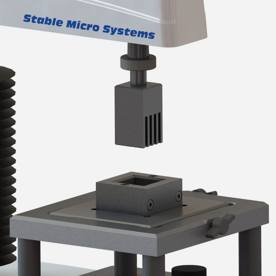
Miniature Kramer/Ottawa Cell
According to AACC Standard Method 56-36.01
True shear rigs
Unlike empirical cutting, true shear fixtures apply opposing forces to stress the material within its own structure:
|
Attachment |
Typical use |
Notes |
|
Bilayer Tablet Shear Rig |
Measuring the integrity/bond strength of layered (bilayer) tablets. |
Designed to shear tablets at the interface to assess adhesion between layers. |
|
Vertical Powder Shear Rig |
Assessing powder compaction behaviour and internal flow/shear properties. |
Used to characterise how powders consolidate and resist shear under vertical loading. |
Materials and bespoke attachments
Bespoke geometries or materials can be produced to customer specification for specialised tests.
Use cases by industry
|
Industry |
Example applications |
Typical Attachment / Blade |
|
Food |
Meat tenderness, noodle bite, fruit or vegetable firmness |
Warner-Bratzler Blade, Asian Noodle Rig |
|
Bakery and confectionery |
Biscuit fracture force, cereal bar cohesiveness |
Light Knife Blade or Kramer Shear Cell |
|
Pharmaceuticals |
Tablet lamination or coating strength |
Bilayer Tablet Shear Rig |
|
Cosmetics |
Wax or gel cutting resistance |
Craft Knife Blade |
Example standard methods using a cutting / shearing test
- AACCI 66-50.01, AACCI 66-52.01 Cooked pasta and spaghetti firmness, respectively.
- ASTM F1306 Film puncture and tear resistance.
- USDA/Honikel methods Standard meat tenderness measurement using Warner-Bratzler Blades.
What else do I need to perform a cutting / shearing test?
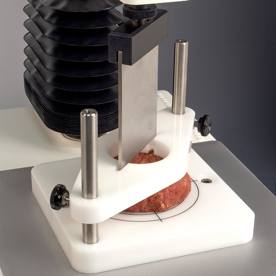
Universal Sample Clamp
To prevent lifting upon blade withdrawal.




Probe Adapters
Probe adapters securely mount and align probes on the Texture Analyser. Magnetic and quick-twist options allow quick, repeatable changeovers, boosting throughput when swapping different probes or running multiple tests.

Heavy Duty Platform
Flat, stable base with sample centralisation concentric rings which also raises the sample test area away from the base of the instrument which may become warm over time and will affect temperature dependent samples.

Calibrated Load Cell
Ensure measurement within correct force range.

Temperature control
For the testing of temperature sensitive samples.

Guard
Protect operators when working with samples that may shatter.

Shatter Screen
Protect operators when working with samples that may shatter.
More examples of how a Texture Analyser performs cutting / shearing tests
People also ask
What does a cutting test measure?
It measures the peak force and total energy required for a blade to slice through a sample, indicating firmness, toughness, or bite strength.
How is a shearing test different from compression?
A shearing test involves lateral cutting motion; compression applies vertical pressure. Both quantify texture but assess different properties.
Which blade is used for meat tenderness testing?
The Blade Set which includes a Warner-Bratzler blade is the most common but there are thinner blade and geometry variants which have been standardised by the USDA and Honikel methods for meat tenderness.
Why use multiple blades in a shear test?
Multi-blade fixtures such as the Kramer Shear Cell reduce variability across heterogeneous samples, giving more representative results.



